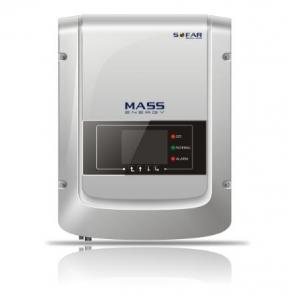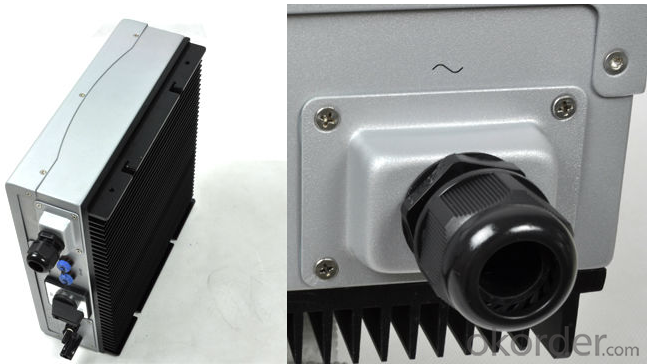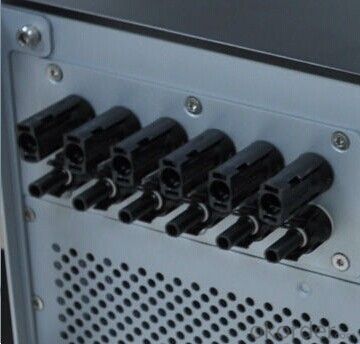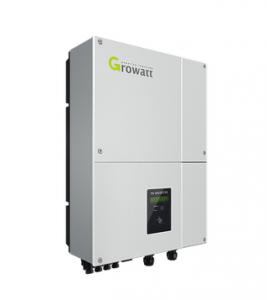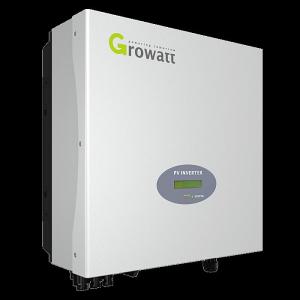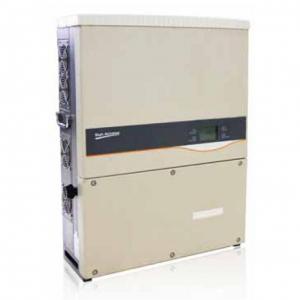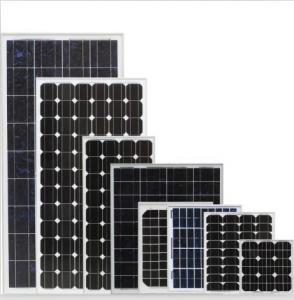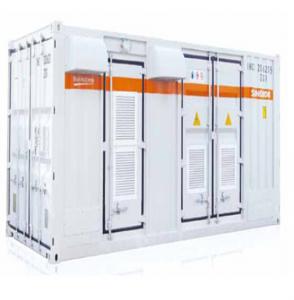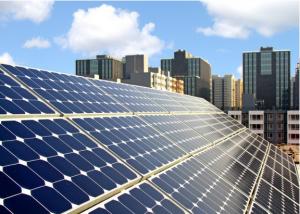Powmr Solar Inverter Grid Connected Solar PV Inverter 2200TL 2200W
- Loading Port:
- Shekou
- Payment Terms:
- TT or LC
- Min Order Qty:
- 10 unit
- Supply Capability:
- 99999 unit/month
OKorder Service Pledge
OKorder Financial Service
You Might Also Like
Grid Connected Solar PV Inverter 2200TL 2200W
High-yield of Solar PV Inverter 2200TL
•Max 97.1%efficiency
•Real timeprecise MPPT algorithm for max harvest
•Wide inputvoltage operation range from 90V to 500V
All in one. Flexible and economicalsystem solution
•Free siteselection due to IP65
•Easy installationand maintenance due to “Plug & Play” connection
•Interfaceselection-Wi-Fi/ RS485 / Dry Relay for more flexible
•configurationandsystem monitoring
•4” LCDdisplay
•
Low maintenance cost of PV inverter
•Rust-freealuminumcovers
•Flexiblemonitoring solution
•Multifunctionrelay can be configured to show various inverter information
Intelligent grid management
•Reactivepowercapability
•Self powerreduce when over frequency
•Remoteactive/reactivepower limit control
PV inverter datasheet
Technical Data | 1100TL | 1600TL | 2200TL | 2700TL | 3000TL | |
Input (DC) | ||||||
Max. Input Power | 1100W | 1600W | 2200W | 2700W | 3000W | |
No. of MPPT / String per MPPT | 1/1 | |||||
Max. Input voltage | 450V | 450V | 500V | 500V | 500V | |
Max. Input Voltage | 80V | |||||
Rated input voltage | 360V | |||||
Operating input voltage range | 90V-400V | 100V-480V | ||||
MPPT voltage range | 110V-380V | 165V-380V | 170-450V | 210-450V | 230V-450V | |
Max. Input current per MPPT | 10A | 13A | ||||
Input short circuit current per MPPT | 12A | 15A | ||||
Output(AC) | ||||||
Rated power(@230V,50Hz) | 1000VA | 1500VA | 2000VA | 2500VA | 2800VA | |
Max. AC power | 1000VA | 1500VA | 2000VA | 2500VA | 2800VA | |
Max. AC Output Current | 4.5A | 7A | 9.5A | 11.5A | 13A | |
Rated Grid Voltage | 230V | |||||
Nominal Grid Voltage Range | 180V-270V(According to local standard) | |||||
Rated Frequency | 50Hz / 60Hz | |||||
Grid frequency Range | 44~55 / 54~66Hz(According to local standard) | |||||
THDi | <3% | |||||
Power factor Adjustable Range | 0.8 over excited … 0.8 under excited | |||||
Grid connection | Single phase | |||||
Efficiency | ||||||
Max. efficiency | 97% | 97.1% | ||||
Weighted eff.(EU/CEC) | 96% | 96.2% | 96.3% | |||
MPPT efficiency | >99.5% | |||||
Standard | ||||||
EMC | EN 61000-6-1, EN 61000-6-2, EN 61000-6-3, EN 61000-6-4 | |||||
RSSR | IEC 62109-1, IEC 62109-2 | |||||
Grid Standards | AS4777, VDE4105, C10-C11, G83/G59 (more available on request) | |||||
Protection | ||||||
Anti-Islanding Protection | Yes | |||||
DC reverse polarity protection | Yes | |||||
Over Temp Protection | Yes | |||||
Leakage Current Protection | Yes | |||||
Over Voltage Protection | Yes | |||||
Over Current Protection | Yes | |||||
Earth Fault Protection | Yes | |||||
Communication | ||||||
Standard Communication Mode | Wifi+RS485 | |||||
Operation Data Storage | 25 years | |||||
Relay | Yes | |||||
I/O | Yes | |||||
General data | ||||||
DC Switch | optional | |||||
Ambient temperature range | -25℃ ~ +60℃ | |||||
Topology | Transformerless | |||||
Cooling | Nature | |||||
Allowable relative humidity range | 0 ~ 95% no condensing | |||||
Max. Operating Altitude | 2000m | |||||
Noise | <35dB @1m | |||||
Degree of Protection (per IEC 60529) | IP65 | |||||
Dimension | 400*310*130mm | |||||
Weight | 11kg | 12kg | ||||
Self-consumption at night | 0 | |||||
Display | Graphic display | |||||
Warranty | 5 years | |||||

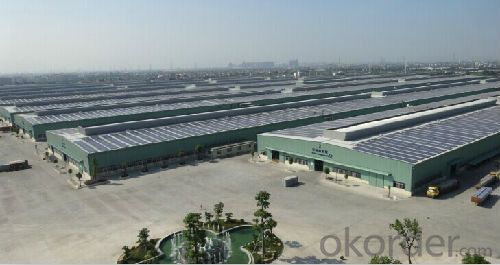
FAQ
1. Have any design tool and how to use it?
Shine Design is the system design software just for inverters, It can conduct installers to figure out panel numbers for a system, panel numbers for each string, and which inverter model is suitable for the system. Moreover, it can print a design report after input all necessary parameters, can calculate DC/AC wire wastage, annual generation, etc.
2. Does the inverter have monitoring solutions for residential system?
For small rating system, we have wired two monitoring solution (ShineNet via RS232 or RS485). (a) Local wireless monitoring solution (ShineVision via RF module communication) (b) Global wireless monitoring solution (WIFI module via WIFI network)
- Q: Can a solar inverter be used in systems with different module capacities?
- Yes, a solar inverter can be used in systems with different module capacities. Solar inverters are designed to convert the DC power generated by solar modules into AC power for use in homes or businesses. They are typically flexible and compatible with a wide range of module capacities, allowing them to be used in systems with varying sizes and configurations. However, it is important to ensure that the inverter's capacity matches or exceeds the total capacity of the connected solar modules to ensure optimal performance and efficiency.
- Q: What are the safety measures to consider when installing a solar inverter?
- When installing a solar inverter, there are several important safety measures to consider. Firstly, it is crucial to turn off the main electrical supply before beginning any installation work. This will prevent the risk of electric shock or injury. Additionally, it is important to wear appropriate personal protective equipment (PPE) such as gloves, safety glasses, and non-slip footwear to ensure personal safety during the installation process. Another safety measure is to ensure proper grounding of the solar inverter system to prevent electrical faults and potential fire hazards. Furthermore, it is essential to follow the manufacturer's instructions and guidelines for installation to ensure proper wiring and avoid any potential electrical hazards. Regular maintenance and inspections should also be conducted to identify and address any potential safety issues or malfunctions. Overall, prioritizing safety measures during the installation of a solar inverter is crucial to minimize risks and ensure the safe and efficient operation of the system.
- Q: Can a solar inverter be used in a mobile or portable solar power system?
- Yes, a solar inverter can be used in a mobile or portable solar power system. Solar inverters are designed to convert the DC (direct current) electricity generated by solar panels into AC (alternating current) electricity that can be used to power various devices. In a mobile or portable solar power system, the solar inverter plays a crucial role in converting the energy collected by the solar panels into a usable form for powering appliances or charging batteries.
- Q: What is the role of an anti-islanding feature in a solar inverter?
- The role of an anti-islanding feature in a solar inverter is to ensure the safety of utility workers and prevent damage to the electrical grid. It detects when there is a power outage or grid disturbance and immediately shuts off the solar inverter to prevent it from continuing to generate electricity. This feature is crucial as it prevents the solar system from operating independently and feeding power back into the grid, which can be dangerous for utility workers trying to repair the power outage.
- Q: Can a solar inverter be used with a remote control system?
- Yes, a solar inverter can be used with a remote control system. Many modern solar inverters are equipped with built-in communication capabilities, such as Wi-Fi or Ethernet connectivity, which allows them to be remotely monitored and controlled. This enables users to adjust settings, monitor energy production, and receive real-time alerts or notifications through a remote control system.
- Q: How does a solar inverter handle different temperature conditions?
- A solar inverter is designed to handle different temperature conditions by incorporating various features and mechanisms. Firstly, it is equipped with a temperature sensor that continuously monitors the inverter's internal temperature. If the temperature exceeds a certain threshold, the inverter activates cooling mechanisms such as fans or heatsinks to dissipate the heat and prevent overheating. Additionally, the inverter's components are selected and designed to withstand a wide range of temperatures, ensuring their functionality and longevity even in extreme conditions. Furthermore, modern inverters often have built-in protective measures like thermal derating, which reduces the inverter's power output as the temperature rises, ensuring it operates within safe limits. Overall, solar inverters are engineered to adapt and operate efficiently in varying temperature conditions for optimal performance and reliability.
- Q: How does a solar inverter handle voltage unbalance?
- A solar inverter handles voltage unbalance by continuously monitoring the phase voltages of the grid. If a voltage unbalance occurs, the inverter adjusts its output voltage and frequency to maintain a balanced supply to the grid. This ensures that the solar inverter can efficiently convert the DC power generated from the solar panels into AC power that is synchronized with the grid, despite any voltage imbalances.
- Q: What are the typical efficiency ranges for different types of solar inverters?
- The typical efficiency ranges for different types of solar inverters can vary depending on factors such as the technology used, the quality of the inverter, and the specific application. However, in general, string inverters typically have efficiency ranges of around 95% to 98%, while microinverters can achieve efficiencies ranging from 95% to 99%. On the other hand, central inverters, which are commonly used in large-scale solar installations, often have efficiency ranges of 97% to 99%. It's important to note that these are average ranges, and actual efficiency can vary depending on various factors and specific product specifications.
- Q: What is the role of a voltage control unit in a solar inverter?
- The role of a voltage control unit in a solar inverter is to regulate and maintain a consistent output voltage from the solar panels. It ensures that the electricity generated by the panels is converted and supplied at the appropriate voltage levels to meet the requirements of the connected devices or the grid. By controlling the voltage, it helps optimize the efficiency and reliability of the solar inverter system.
- Q: Can a solar inverter be used with a solar-powered remote sensing system?
- Yes, a solar inverter can be used with a solar-powered remote sensing system. The solar inverter is responsible for converting the direct current (DC) generated by the solar panels into alternating current (AC) that can be used to power the remote sensing system. This allows for the efficient and reliable operation of the remote sensing system using solar energy as the primary power source.
Send your message to us
Powmr Solar Inverter Grid Connected Solar PV Inverter 2200TL 2200W
- Loading Port:
- Shekou
- Payment Terms:
- TT or LC
- Min Order Qty:
- 10 unit
- Supply Capability:
- 99999 unit/month
OKorder Service Pledge
OKorder Financial Service
Similar products
Hot products
Hot Searches
Related keywords

